Salisbury: Difference between revisions
| Line 97: | Line 97: | ||
==Geography== | ==Geography== | ||
[[File:Queen Elizabeth Gardens 2011.jpg|right|thumb|200px|Queen Elizabeth Gardens showing part of the Avon diverted through the gardens]] | [[File:Queen Elizabeth Gardens 2011.jpg|right|thumb|200px|Queen Elizabeth Gardens showing part of the Avon diverted through the gardens]] | ||
Salisbury lies in a valley. The geology of the area, like much of South Wiltshire and [[Hampshire]], is largely chalk. Five rivers meet here, though as they flow through the city they have been redirected, and along with landscaping, have been used to feed into public gardens. The | Salisbury lies in a valley. The geology of the area, like much of South Wiltshire and [[Hampshire]], is largely chalk. Five rivers meet here, though as they flow through the city they have been redirected, and along with landscaping, have been used to feed into public gardens. The meadows by the rivers are popular in the summer, particularly ''Queen Elizabeth Gardens'' as the water there is shallow and slow-flowing enough to enter safely. Close to Queen Elizabeth Gardens are water-meadows, where the water is controlled by weirs. Because of the low-lying land, the rivers are prone to flooding particularly during the winter months. The ''Town Path'', a walkway that links [[Harnham]] with the rest of the city, is at times impassable. | ||
There is no motorway that links the ports of [[Southampton]] and [[Bristol]] meaning that all traffic in that direction must pass through the city, causing "interesting" traffic notwithstanding internal bypass roads. | There is no motorway that links the ports of [[Southampton]] and [[Bristol]] meaning that all traffic in that direction must pass through the city, causing "interesting" traffic notwithstanding internal bypass roads. | ||
Latest revision as of 15:30, 28 October 2022
| Salisbury | |
| Wiltshire | |
|---|---|
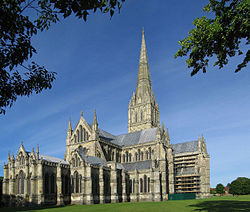 Salisbury Cathedral | |
| Location | |
| Grid reference: | SU145305 |
| Location: | 51°4’26"N, 1°47’37"W |
| Data | |
| Population: | 39,726 (2001) |
| Post town: | Salisbury |
| Postcode: | SP1, SP2 |
| Dialling code: | 01722 |
| Local Government | |
| Council: | Wiltshire |
| Parliamentary constituency: |
Salisbury |
Salisbury is a beautiful cathedral city in Wiltshire. It is the county's only city and its largest town after Swindon. The city is also known as New Sarum, by which name it is known in the city's charters up to the twentieth century, albeit that this name is not used locally. The name of New Sarum distinguishes it from Old Sarum, the original site of Salisbury win a hill-fort to the north of today's city.
The city is a mediæval foundation centred on its soaring Cathedral. A great deal of mediæval architecture remains, and yet more from later ages adding to the charm of the city.
The city stands in south-eastern of Wiltshire, near the edge of Salisbury Plain. It sits where five rivers meet: the Nadder, Ebble, Wylye and Bourne are tributaries of the Avon, which flows to the south coast and into the sea at Christchurch, Hampshire. Water meadows wet from the five rivers and their manifold channels are spread into the heart of the city behind the Cathedral Close.
Name of the city
The name of Salisbury first belonged to the hill-fort town now known as Old Sarum, which was the original site of the city. The name is from the ancient British language, of unknown meaning. The Romans called it Sorviodunum (in which 'dun' is the British for "hill" or "hill-fort")
In the Anglo-Saxon period, the English named the town Searesburg[1][2][3] which name is derived from the British original; the English burg replacing the Welsh dun, and this was corrupted in the Middle Ages to "Salisbury". In the Domesday Book the town is recorded as "Salesberie".[4]
The name naturally transferred to the new city by the rivers when it was founded (officially as "New Sarum") in 1220.
The origin of the name "Sarum" is obscure. It most likely to derive from a Latin abbreviation. The name of Saresberie or Saresburgium (when Latinised) would have been abbreviated in the manner of the mediæval scribes to Sar with a stroke over the "r", but that mark was also the common symbol for the Latin termination "-um". Hence "Sar" with a stroke over the r would be re-renderd as "Sarum". One of the first known uses of "Sarum" is on the seal of Saint Nicholas Hospital, Salisbury, which was in use in 1239. Bishop Wyville (1330–1375) was the first Bishop to describe himself "episcopus Sarum".[5]
History
Old Sarum
Salisbury originally stood on a hill to the north of today's city, at the site known as Old Sarum. There is evidence of Neolithic settlement on the hilltop of Old Sarum. It became a hill fort in the Iron Age. The Romans called this fort "Sorviodunum" and may also have occupied the fort.
The English captured these lands from the Britons in the sixth century and established themselves there, calling the hill and the town "Searesbyrig"[1][2][3] which name was corrupted in the Middle Ages to "Salisbury".
At the Normans conquest, King William held court at Salisbury, which is to say Old Sarum, on one occasion to receive the homage of local landowners. He also ordered the removal of the local bishopric to Salisbury. In the Domesday Book the town is known as "Salesberie".[4]
The Normans built a castle at Salisbury. The first Salisbury Cathedral was built on the hill by St Bishop Osmund between 1075 and 1092. A larger building was built on the same site circa 1120. However, deteriorating relations between the clergy and the military at Old Sarum led to the decision to re-site the cathedral elsewhere. Even in the 12th century, Peter of Blois had described the old church as "a captive within the walls of the citadel like the ark of God in the profane house of Baal". He made the appeal:
Let us descend into the plain! There are rich fields and fertile valleys abounding in the fruits of the earth and watered by the living stream. There is a seat for the Virgin Patroness of our church to which the world cannot produce a parallel.[6]
New Sarum
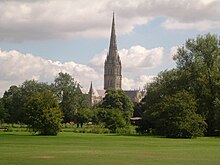
Bishop Peter's idea to move to the plain by the rivers did not wait long. In 1219 Richard Poore, the then Bishop of Sarum, decided to establish a new town and cathedral on an estate in his possession in the valley, on the banks of the River Avon. The estate, oddly, was known as Veteres Sarisberias - Old Salisburys – and the meadow on which the town was founded was a great meadow called 'Merrifield'.[6] The bishop began the building of the new cathedral in the same year.
The new town was laid out in a grid pattern, and work started in 1220, with the cathedral commencing the following year. The town developed rapidly, and by the 14th century was the foremost town in Wiltshire. The city wall surrounds the Close and was built in the 14th century. The town remained under the control of the Bishops of Salisbury for centuries.
In 1226, King Henry III granted the Bishop of Salisbury a charter to hold a fair lasting 8 days from the Feast of the Assumption of Mary (15 August).[7] Over the centuries the dates for the fair have moved around, but in its modern guise, a funfair is now held in the Market Place for three days from the third Monday in October. However, there is still an ancient law stating that the fair can be held in the Cathedral Close.
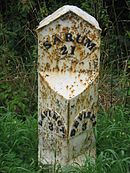
The original site of the city at Old Sarum fell into disuse. Nevertheless, its charter remained in place and with it the right to elect two members of parliament, notwithstanding that by the modern period there were but three households in the borough of Old Sarum: it was a rotten borough whose representation in Parliament was abolished only in the nineteenth century.
The city established
In May 1289, there was uncertainty about the future of Margaret, Maid of Norway, heir to the thrones of Scotland and Norway, who was to be betrothed to Edward, Prince of Wales. Her father Eric sent ambassadors to Edward I of England. Edward met Robert the Bruce and others at Salisbury in October 1289, which resulted in the Treaty of Salisbury, under which Margaret would be sent to Scotland before 1 November 1290 and any agreement on her future marriage would be delayed until she was in Scotland.[8] In the event, Margaret died on the voyage from Norway.
In 1450, a number of riots broke out at roughly the same time Jack Cade led a famous rebellion through London. The riots were for related reasons to those of Jack Cade and his followers, however the decline of the cloth trade may have also been influential. The violence peaked with the murder of William Ayscough, Bishop of Salisbury. The Bishop was branded a traitor for his involvement in a governing clique perceived responsible for mis-government of the realm by both the rebels in London and Salisbury.
In 1483, a large-scale rebellion against Richard III of England broke out, led by his own 'kingmaker', Henry Stafford, 2nd Duke of Buckingham. After the revolt collapsed, Buckingham was executed at Salisbury, near the Bull's Head Inn.
At the time of the Glorious Revolution, King James II gathered his main forces, altogether about 19,000 men, at Salisbury, James himself arriving in the city on 19 November 1688. His soldiers were not keen to fight William and Mary, and the loyalty of many of his commanders was in doubt. The first blood was shed at Wincanton, in Somerset. In Salisbury, James heard that some of his officers had deserted, including Edward Hyde, and he broke out in a nose-bleed which he took as an omen that he should retreat. His commander in chief, the Earl of Feversham, advised retreat on 23 November, and the next day John Churchill deserted to William. On 26 November, James's own daughter, Princess Anne, did the same, and James returned to London the same day, never again to be at the head of a serious military force in England.[9]
The novel Sarum by Edward Rutherfurd, published in 1987, is an imaginative retelling of the history of Salisbury from the end of the Ice Age to the present day.
Salisbury Cathedral
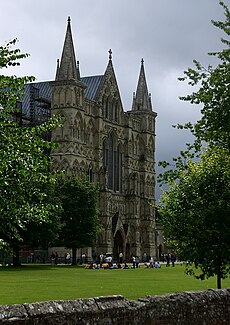
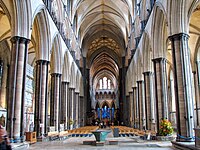
The Cathedral, seat of the Diocese of Salisbury, is the centre around which Salisbury was built in the thirteenth century, and it remains to day the heart of the city and its focal point. The great spire, the highest in the United Kingdom, can be seen from all across the city and beyond.
The cathedral is built on a gravel bed with unusually shallow foundations of 18 inches on wooden faggots: the site is supposed to have been selected by shooting an arrow from Old Sarum, although this can only be legend as the distance is over 2 miles. It is sometimes claimed the arrow hit a white deer, which continued to run and died on the spot where the Cathedral now exists, though this sounds like special pleading.
Work began on the cathedral in 1221, the year after the town of New Sarum, today’s Salisbury, was founded. The main body was completed in only 38 years and is a masterpiece of Early English architecture. Some stones which make up the cathedral came from Old Sarum, others from the Chilmark Quarries from where they were most likely moved to the cathedral building site by ox-cart. The existence of many water-mills and weirs probably prevented transport on boats on the River Nadder. The spire, 404 feet high, was built later and is the tallest spire in the United Kingdom.
The total length of the Cathedral's interior is 449 feet. The width of nave and aisles excluding transepts is 78 feet. The Width north-south in the main transepts is 204 feet. The height of the nave is 85 feet and the height to the vault excluding the Trinity Chapel is 85 feet. The length of nave is 230 feet. It has seating capacity for 1,900 people.
The spire stands 404 feet high, supported by four 6-foot square main piers, and strengthened by further buttresses.
The cathedral contains the best preserved of the four surviving copies of the Magna Carta and a large mechanical clock installed in the cathedral in 1386 - the oldest surviving mechanical clock in Britain.
Chapter House and Magna Carta
Attached to the body of the Cathedral is the Chapter House. It is a distinctive octagonal shape, supported by a slender central pillar and decorative mediæval frieze. It was redecorated in 1855-9 by William Burges.
The frieze circles the interior, just above the stalls; a remarkable work, it depicts in fine detail scenes from the books of Genesis and Exodus, including Adam and Eve, Noah, the Tower of Babel, and Abraham, Isaac and Jacob.
The chapter house also displays the best-preserved of the four surviving original copies of Magna Carta. This copy came to Salisbury because Elias of Dereham, who was present at Runnymede in 1215, was given the task of distributing some of the original copies. Later, Elias became a Canon of Salisbury and supervised the construction of Salisbury Cathedral.
Cathedral Close
The Close surrounds the Cathedral, and it is here that the most sought-after houses in Salisbury are found. There are five gates in the wall around the Close; four are original, known as the High Street Gate, St Ann's Gate, the Queen's Gate, and St Nicholas's Gate. A fifth was created in the 19th century to allow access to Bishop Wordsworth's School located inside the Cathedral Close. A room located above St Ann's Gate is where the composer Handel stayed, writing several works while there.
During the Great Plague of London, King Charles II held court in the Close.
Cathedral constables
Until 2010, the Cathedral employed five constables (known as "Close Constables"). Their duties mainly concerned the maintenance of law and order in the Cathedral Close. As part of cost-cutting measures in 2010 they were replaced by "traffic managers".[10]
Constables were first appointed when the Cathedral became an autonomous liberty in 1611, and survived until the introduction of municipal police forces in 1835. In 1800 they were given the power, along with the city constables, to execute any justices’ or court order requiring the conveyance of prisoners to or from the county gaol (at Fisherton Anger, then outside the city of Salisbury) as if it were the city gaol (and, in so doing, they were made immune from any legal action for acting outside their respective jurisdictions).[11] The right of the Cathedral, as a liberty, to maintain a separate police force was terminated in 1889.
Geography
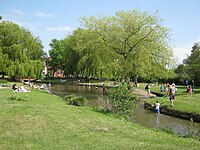
Salisbury lies in a valley. The geology of the area, like much of South Wiltshire and Hampshire, is largely chalk. Five rivers meet here, though as they flow through the city they have been redirected, and along with landscaping, have been used to feed into public gardens. The meadows by the rivers are popular in the summer, particularly Queen Elizabeth Gardens as the water there is shallow and slow-flowing enough to enter safely. Close to Queen Elizabeth Gardens are water-meadows, where the water is controlled by weirs. Because of the low-lying land, the rivers are prone to flooding particularly during the winter months. The Town Path, a walkway that links Harnham with the rest of the city, is at times impassable.
There is no motorway that links the ports of Southampton and Bristol meaning that all traffic in that direction must pass through the city, causing "interesting" traffic notwithstanding internal bypass roads.
There are civil airfields at Old Sarum (where the experimental aircraft the Edgley Optica was developed and tested) and nearby at Thruxton near Andover.
Economy
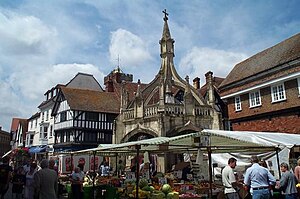
Salisbury holds a market on Tuesdays and Saturdays and has held markets regularly since 1227. In the 15th century the Market Place was dotted with stone crosses marking the centres for certain trades and goods. Today only the Poultry Cross remains, to which flying buttresses were added in 1852. The other crosses were the Livestock Cross, the Cheese & Milk Cross and the Wool & Yarn Cross.
The market granted by King Henry III in 1226 continues but over the centuries the dates for the fair have moved around, but in its modern guise, a funfair is now held in the Market Place for three days from the third Monday in October.
Stonehenge, which is a UNESCO World Heritage Site is about 8 miles northwest of Salisbury and greatly aids the local economy. The city is always busy wihg visitors, drawn by the city's charm, the Cathedral and Close, and nearby Old Sarum.
Culture
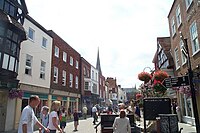
Salisbury was an important centre for music in the 18th century. The grammarian James Harris, a friend of Handel, directed concerts at the Assembly Rooms for almost 50 years up to his death in 1780, with many of the most famous musicians and singers of the day performing there.[12]
Salisbury holds an annual St George's Day pageant, the origins of which are claimed to go back to the thirteenth century.
Salisbury has a strong artistic community, with galleries situated in the city centre, including one in the public library. In the 18th century, John Constable, more famous for painting his native Suffolk, made a number of celebrated landscape paintings featuring the cathedral spire and the surrounding countryside.
Salisbury's annual International Arts Festival, started in 1973, and held in late May to early June, provides a programme of theatre, live music, dance, public sculpture, street performance and art exhibitions. Salisbury also houses a producing theatre - Salisbury Playhouse - which produces between eight and ten plays a year, as well as welcoming touring plays.
Salisbury and South Wiltshire Museum
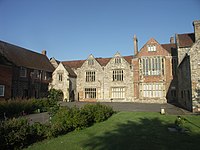
The Salisbury and South Wiltshire Museum is housed in the King's House in the Cathedral Close. The house is a Grade I listed building whose history dates back to the 13th century, standing just opposite the west front of the Cathedral.
The permanent Stonehenge exhibition gallery has interactive displays about Stonehenge and the archaeology of south Wiltshire, and its collections include the skeleton of the Amesbury Archer, which is on display.
The Pitt Rivers gallery holds a collection from General Augustus Pitt Rivers, often called the "father of modern archaeology".
The costume gallery showcases costume and textiles from the area with costumes for children to try on and imagine themselves as characters from Salisbury's past.
Leisure
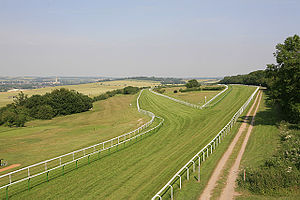
- The Bishop's Walk on the edge of the city provides a popular viewing point
- The local theatre is the Salisbury Playhouse.
- Salisbury is well-supplied with pubs. 'The Haunch of Venison', overlooking the market, still operates from a 14th-century building. One of its attractions is a plaster cast of a mummified hand, supposedly severed during a game of cards. The hand vanished in 2004 as a publicity stunt for the pub but later reappeared and can still be seen there.[13] The Rai d’Or has original deeds dating from 1292. It was the home of Agnes Bottenham who used the profits of the tavern to found Trinity Hospital next door in around 1380.
- The City Hall is an entertainment venue and hosts comedy, musical performances as well as seminars and conventions
- Salisbury Arts Centre [14] has exhibitions and workshops.
Sports clubs
- Football: Salisbury City FC
- Rugby: Salisbury
- Salisbury Racecourse is a flat racing course to the south-west of the city
Media
- Radio:
- Spire FM
- BBC Wiltshire
- Newspapers:
- The 'Salisbury Journal (weekly)
- The Avon Advertiser (free)
In fiction
Salisbury has inspired countless books and scenes from literature, and is often a backdrop for television. Some notable appearances in literature include:
- In Thomas Hardy's Wessex novels, Salisbury appears fictionalised as "Melchester" in such novels as Jude the Obscure (1895).
- Martin Chuzzlewit by Charles Dickens has a lively account of the Salisbury markets, as they were in 1842
- The Pillars of the Earth by Ken Follett (also a 2010 television mini-series) has the fictitious Kingsbridge Cathedral, modeled on the cathedrals of Wells and Salisbury. The final aerial shot of the series is of Salisbury Cathedral.
- The novel Sarum by Edward Rutherfurd describes the history of Salisbury.
- The novel The Spire by William Golding tells the story of the building of the spire on Salisbury Cathedral.
Outside links
| ("Wikimedia Commons" has material about Salisbury) |
- Salisbury Cathedral
- Salisbury City Council
- Salisbury Tourism website
- Let Me Tell You: Salisbury- a BBC film about life in the city in 1967
- Historic Salisbury photos at BBC Wiltshire
References
- ↑ 1.0 1.1 Samuel, Lewis.'Lewis's Topographical dictionary of England: Volume Four'. S. Lewis, 1835, Indiana University
- ↑ 2.0 2.1 Cameron, Kenneth 'English Place-Names'. Batsford, 1988, University of Michigan. ISBN 0713456981, 9780713456981. Length: 264 pages. Page 35
- ↑ 3.0 3.1 Blake, Norman Francis. Jones, Charles. University of Sheffield. Dept. of English Language. 'English Historical Linguistics: Studies In Development:Issue 3 of CECTAL Conference Papers Series, CECTAl (Sheffield)'. Centre for English Cultural Tradition and Language, University of Sheffield for the Department of English Language, University of Sheffield, 1984. Length: 313 pages
- ↑ 4.0 4.1 http://www.wiltshire.gov.uk/community/getcom.php?id=193
- ↑ Victoria History of Wiltshire Vol. VI, pp. 93-94
- ↑ 6.0 6.1 George Walter Prothero, The Quarterly Review, Volume 103, p. 115 online at books.google.com
- ↑ "Wiltshire". Gazetteer of Markets and Fairs in England and Wales to 1516. Centre for Metropolitan History. http://www.history.ac.uk/cmh/gaz/wilts.html. Retrieved 12 April 2010.
- ↑ Oram, Canmore Kings, p. 109
- ↑ J. Childs, The Army, James II, and the Glorious Revolution (Manchester, 1980)
- ↑ Hough, Andrew (6 August 2010). "Anger after Salisbury Cathedral Constables 'scrapped to save money'". The Daily Telegraph. http://www.telegraph.co.uk/news/newstopics/howaboutthat/7928053/Anger-after-Salisbury-Cathedral-Constables-scrapped-to-save-money.html. Retrieved 24 January 2011.
- ↑ "Statute Law Revision: Gaols: Repeal Proposals". Law Commission. April 2006. Archived from the original on 2 February 2011. http://webarchive.nationalarchives.gov.uk/20110202093443/http://www.lawcom.gov.uk/docs/gaols.pdf. Retrieved 17 June 2011.
- ↑ Music and Theatre in Handel's World: The Family Papers of James Harris 1732-1780, by Donald Burrows and Rosemary Dunhill, Oxford University Press, USA (March 29, 2002)
- ↑ "BBC Wiltshire". BBC News. 2004-03-16. http://news.bbc.co.uk/1/hi/england/wiltshire/3515304.stm. Retrieved 2010-07-17.
- ↑ "Home - Salisbury Art Centre". Salisburyartscentre.co.uk. http://www.salisburyartscentre.co.uk/home.aspx. Retrieved 2010-07-17.
| Cities in the United Kingdom |
|---|
|
Aberdeen • Armagh • Bangor (Caernarfonshire) • Bangor (County Down) • Bath • Belfast • Birmingham • Bradford • Brighton and Hove • Bristol • Cambridge • Canterbury • Cardiff • Carlisle • Chelmsford • Chester • Chichester • Colchester • Coventry • Derby • Doncaster • Dundee • Dunfermline • Durham • Ely • Edinburgh • Exeter • Glasgow • Gloucester • Hereford • Inverness • Kingston upon Hull • Lancaster • Leeds • Leicester • Lichfield • Lincoln • Lisburn • Liverpool • City of London • Londonderry • Manchester • Milton Keynes • Newcastle upon Tyne • Newport • Newry • Norwich • Nottingham • Oxford • Perth • Peterborough • Plymouth • Portsmouth • Preston • Ripon • Rochester • Salford • Salisbury • Sheffield • Southampton • St Albans • St Asaph • St David's • Southend-on-Sea • Stirling • Stoke-on-Trent • Sunderland • Swansea • Truro • Wakefield • Wells • Westminster • Winchester • Wolverhampton • Worcester • Wrexham • York |
